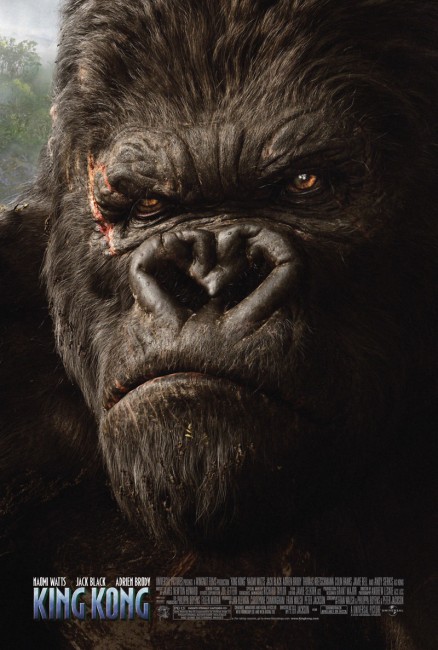USA/New Zealand. 2005.
Crew
Director – Peter Jackson, Screenplay – Peter Jackson, Philippa Boyens & Fran Walsh, Based on the Screenplay by Merian C. Cooper & Edgar Wallace, Producers – Peter Jackson, Fran Walsh, Jan Blenkin & Carolynne Cunningham, Photography – Andrew Lesnie, Music – James Newton Howard, Visual/Makeup/Creature/Miniatures Supervisor – Richard Taylor, Animation Supervisors – Eric Leighton & Christian Rivers, Visual Effects – Weta Digital Ltd, Additional Visual Effects – Asylum & Cafe FX, Special Effects Supervisor – Steven Ingram, Creature Effects – Weta Workshop, Production Design – Grant Major. Production Company – Wingnut Films/Universal.
Cast
Naomi Watts (Ann Darrow), Jack Black (Carl Denham), Adrien Brody (Jack Driscoll), Thomas Kretschmann (Captain Englehorn), Jamie Bell (Jimmy), Evan Parke (Hayes), Andy Serkis (Kong/Lumpy), Kyle Chandler (Bruce Baxter), Colin Hanks (Preston), John Sumner (Herb), Lobo Chan (Choy)
Plot
New York City during the height of The Depression. Movie producer Carl Denham finds that his financial backers want to can his latest project and so he absconds with the reels of film. Searching for new leading lady, he comes across down-and-out actress Ann Darrow and persuades her to join the production. Boarding the tramp freighter Venture, they set sail for what he claims is Singapore – but instead Denham is following a map he has obtained that leads to an island that is on no charts. Once on the island, the crew face hostile native tribes. The natives sneak aboard the ship and abduct Ann. Trying to rescue her back, the crew are witness as the natives sacrifice Ann as bride to a giant 25 foot tall ape known as Kong. Denham and men struggle through the jungle, facing the dinosaurs and prehistoric wildlife that still thrives there. Meanwhile, Kong becomes taken with Ann and a relationship of sorts grows between them. As Denham’s writer Jack Driscoll struggles through the jungle on his own to save Ann, Denham contrives a plan to capture Kong. They succeed in chloroforming him and transport him back to New York City. Once there however, Kong breaks free and rampages through the city in search of Ann.
King Kong (1933) is one of the undisputed classics of fantastic cinema. The creation of Merian C. Cooper and Ernest B. Schoedsak, two directors who specialized in films shot in remote regions of the world, and special effects artist Willis O’Brien, one of the early pioneers of the art of stop-motion animation, King Kong roared across screens at the height of The Depression. King Kong essentially created the modern monster movie. The Beast from 20,000 Fathoms (1953), Godzilla, Jurassic Park (1993) and countless others owe themselves to King Kong but few have come anywhere near obtaining its sense of a dreamy fairytale that seems more Beauty and the Beast than it ever is a monster movie.
King Kong has been numerously sequelized. First up was the lesser but occasionally amusing The Son of Kong (1933), released a bare eight months after King Kong and featuring many of the personnel and cast behind the first film. In the 1960s, Japan’s Toho Studios obtained the rights to use Kong and paired him against Godzilla in King Kong Vs. Godzilla (1962) and then against a robot double of himself in King Kong Escapes (1967). Then came producer Dino De Laurentiis’s infamously reviled remake King Kong (1976) starring Jessica Lange, which substituted Willis O’Brien’s stop motion effects for a man in a monkey suit and even worse wrote the relationship between Kong and Jessica Lange as a barrage of campy modern one-liners. Even more ridiculous was De Laurentiis’s sequel King Kong Lives (1986), which is one of the most absurd films ever made.
Director Peter Jackson claims that King Kong is one of his favourite films and that it inspired him to become as a filmmaker. Peter Jackson should need no introduction as the New Zealand wunderkind who rose from making hilariously funny no-to-low-budget splatter films – Bad Taste (1988), Meet the Feebles (1990) and Braindead/Deadlive (1992) – to critical acclaim – Heavenly Creatures (1994) – and worldwide success – The Lord of the Rings trilogy, winning an Academy Award, being named the Most Powerful Man in Hollywood by Premiere magazine and becoming the highest paid director in the world. Just after Heavenly Creatures, at around the time that he made his one flop – the ghost comedy The Frighteners (1996) – Jackson announced that his next film would be a remake of King Kong. He had the backing of Universal who intended King Kong for a 1998 release in a year that also held big-budget remakes of Godzilla (1998) and Mighty Joe Young (1998), all CGI redressings of classic monster movies, which in turn had been mounted to capitalize on the popularity of CGI monsters after the enormous success of Jurassic Park. For varying reasons, one being the flop of The Frighteners, Peter Jackson’s King Kong remake never went ahead at the time. Jackson, never one to look back, went away and made his Lord of the Rings trilogy – The Lord of the Rings: The Fellowship of the Ring (2001), The Lord of the Rings: The Two Towers (2002) and The Lord of the Rings: The Return of the King (2003) – to amazing worldwide box-office success.
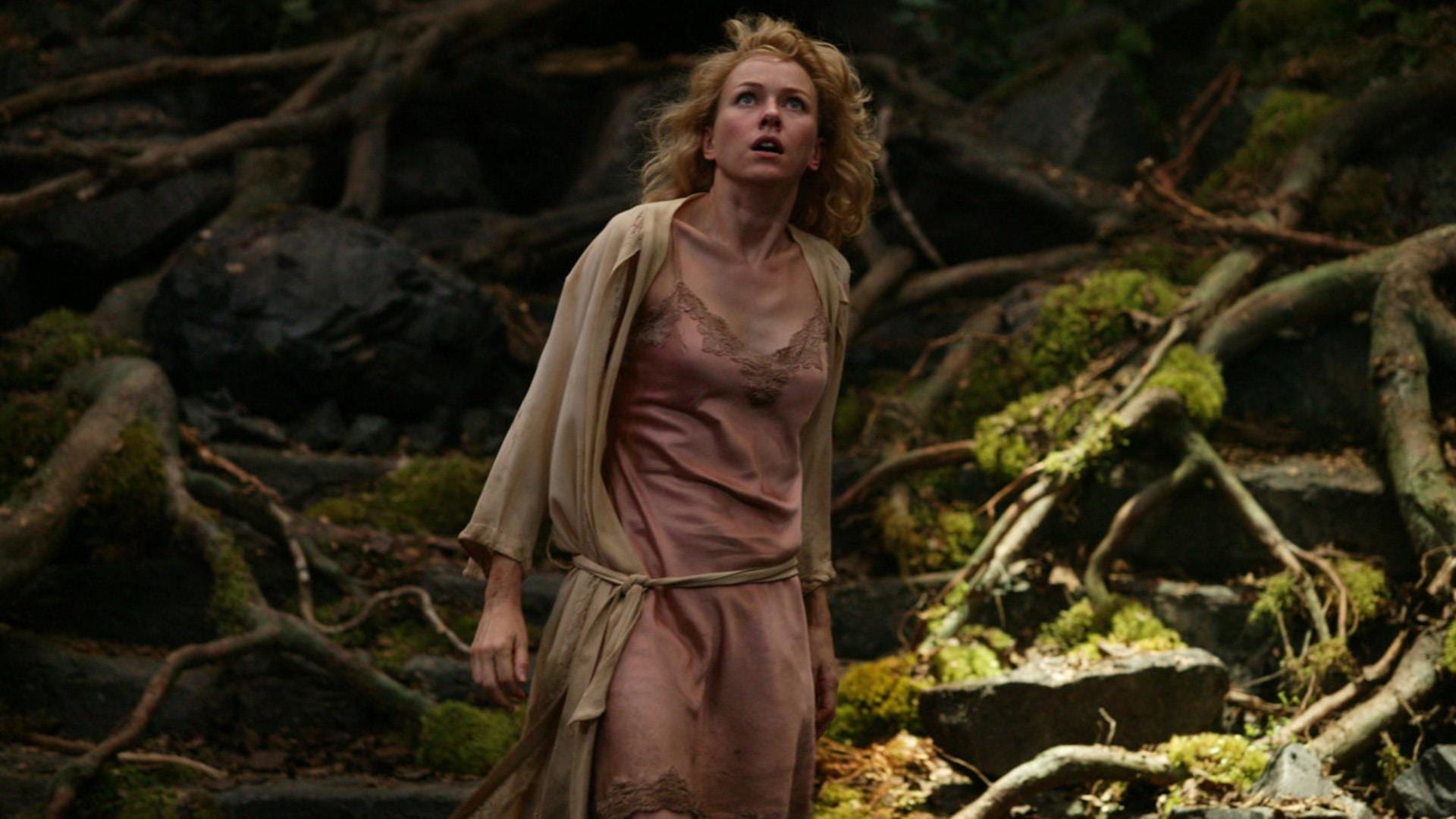
It is perhaps fortuitous that Peter Jackson has the opportunity to remake King Kong nearly a decade later in 2005 rather than back in 1998. Back in 1998, Jackson was a relative unknown on the Hollywood stage, where his greatest acclaim was Heavenly Creatures, which had been a critically lauded festival hit but far from any kind of box-office hit. The achievements that happened following Lord of the Rings – the critical acclaim and public notice, the clout that this success has given him and especially he and his studio’s ability to gain a mastery of the visual effects environment and his gaining his wings in terms of visual style – have granted Jackson the ability to make the King Kong he wanted. It would surely have been a far more compromised version of King Kong that we would ended up with had Jackson made the film back in 1998 when he did not have a world-class visual effects studio of his own, let alone the wherewithal to throw a reputed $22 million of his own money into the film (nearly the budget of an entire smaller feature film) and the freedom from studio interference to follow his own vision.
King Kong is without a doubt a work of dedication and love for Peter Jackson. He has made the film with painstaking dedication – from modelling the creatures off the original stop-motion armatures to digitising footage from the famous missing spider attack sequence, to planning to include a cameo from Fay Wray (dropped when Wray died in August 2004) to the amount of detail lavished on every aspect of the film. Despite all misgivings and potential doubts that many had, King Kong emerges as a dazzling and absolutely magnificent piece of cinema. Indeed, one is prepared to say that King Kong is Peter Jackson’s best film yet.
Peter Jackson and has co-writers have extruded the basics of King Kong out into an epic-sized story. The film treats every detail of the original with the utmost reverence and pads it out onto a massive-sized stage. All the characters from the original, even the minor characters, as well as a host of new ones, have been fleshed out and get their own backstory. This certainly results in a very long film. Where the original King Kong runs at some 100 minutes, the remake is nearly twice that length at 187 minutes – just over three hours long. In this version, it is 60 minutes before we reach Skull Island and 72 minutes (the running time of some films) before we even get to see the Big Monkey himself. This does ask much of the audience – certainly, the crowd I saw the film with did fidget through the first hour.
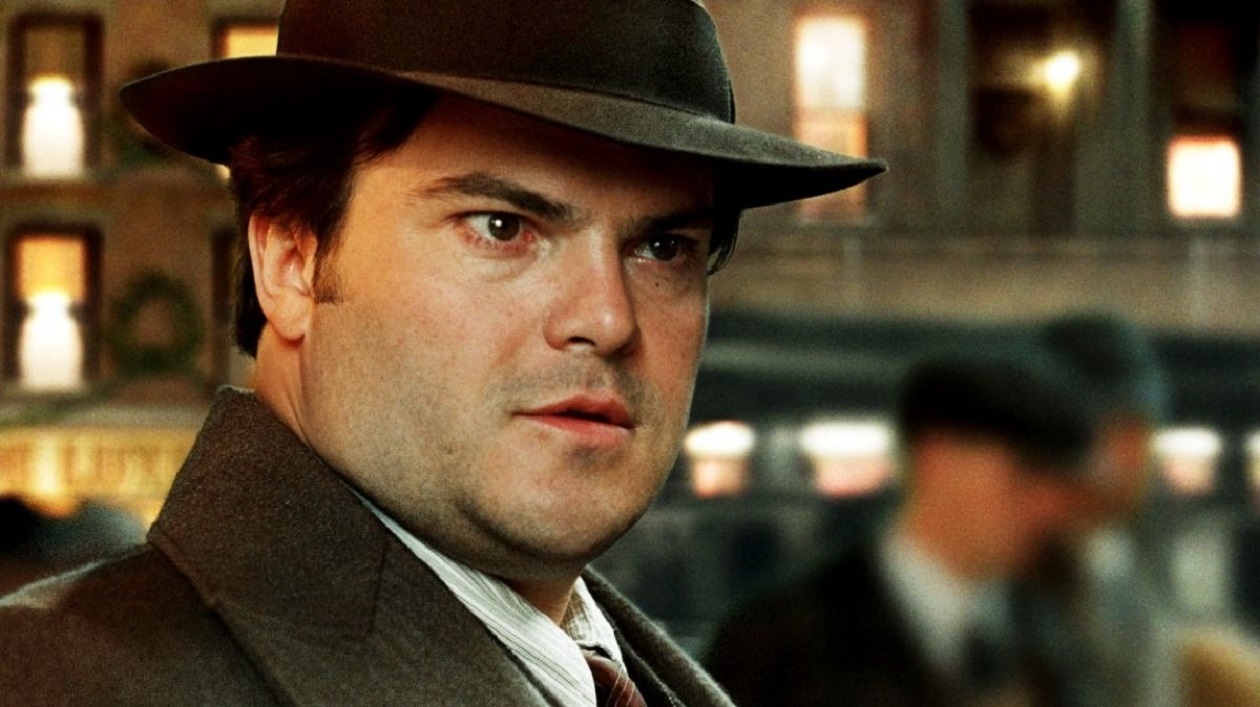
However, when the film does finally gain its feet, Jackson dazzles us. First there is the dramatically seat-edge scene with The Venture crashing onto the rocks, which comes big, expansive and sets the stage in a huge way. Then come the encounters with the natives, ending with the breathtaking image of one of the natives pole-vaulting between the storm-swept rocks to reach the ship. However, the set-piece that kicks the film into action is the stampede of the dinosaurs down a narrow defile and around collapsing cliff-edges, as all the while the frail human crew run to avoid being crushed between their feet or devoured by velociraptors. Here Jackson has an entire audience on the edges of their seats and the stampede is a set-piece that propels King Kong into the big time in a way that stuns.
However, this is only the beginning and the rest of the film comes filled with equally dazzling set-pieces – like the scene where Adrien Brody steals Naomi Watts away down a creeper while Kong deals with a flurry of attacking bats and then attempts to drag the rope back up; Jackson’s recreation and elaboration of the famous deleted scene from the original where the men end up at the bottom of a ravine and are attacked by spiders and other creepy-crawleys; the scene where the ship’s crew attempt to capture Kong; Kong’s rampage through the streets of New York City, battering street cars and Model Ts, while picking up and examining every blonde he comes across; and, of course, the climactic scenes with the biplanes shooting down Kong atop the Empire State Building. The show capper is the encounter between Kong and the dinosaurs, which turns into a real knockdown wrestling match with Kong and the dinosaurs battering one another and Naomi Watts being tossed around like a juggling ball, and Kong, dinosaurs and Naomi all hanging from a net of creepers over the side of a cliff with Naomi jumping from dinosaur snout to snout, trying to avoid being eaten.
Although, the most dazzling special effects creation is simply the character of Kong himself. Be it seeing the big ape standing up to beat his chest, playfully engaged in teasing Naomi Watts or the tearful scenes of him reaching out for her as he goes down chloroformed or at the hands of the biplane bullets, Kong emerges as a creation of dazzling conviction who completely holds our sympathies and attention on screen. It is here that Peter Jackson shows his complete command of cinema. Where most of Jackson’s contemporaries – take note George Lucas, Michael Bay and Stephen Sommers! – are still down around the level of using CGI in showing as many spaceships whizzing about at once as possible or creating bigger explosions, Peter Jackson is someone who has found an ability to not only create spectacle of dazzling awe but to also craft the effects into a poetry of the imagination and find a heartfelt soul amidst it all.
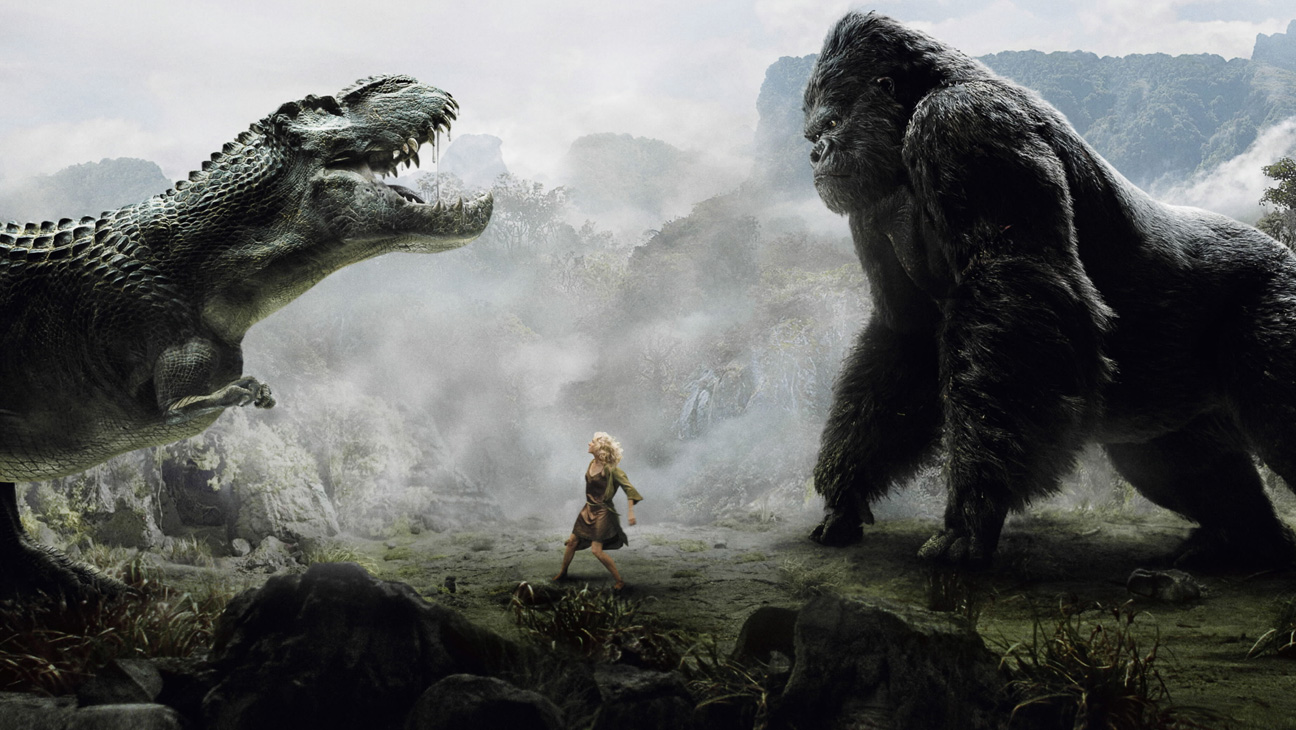
Naomi Watts is an actress that has gained a high profile in recent years. The late Fay Wray is still the actress that will always be associated with King Kong and gave an incomparable performance as the girl in the paw, although Naomi Watts does try hard to stand up to Fay Wray’s enormous stature. Most of the role here is one that merely requires Naomi to scream, fall and slide through foliage. Jackson and cinematographer Andrew Lesnie frame her in a way where she seems to radiate a beatific vulnerability and it is during these largely silent poses that Naomi captures much of Fay Wray’s fearful innocence.
However, Jackson, Fran Walsh et al also explore the relationship between her and Kong in unexpected ways. While the original film was more of a dreamy Beauty and the Beast relationship, the remake is more akin to the classic comedy pairing of the two opposites who come to find a gradual affection for one another through being thrust into the same situation. Kong here seems like a proud and comically petulant majesty who gradually lets this tiny human toy to get under his skin. Some of the most magical scenes in the film are those between Kong and Naomi Watts – the scene where she entertains him by doing her vaudeville slapstick routine and he amuses himself by knocking her down; the delightful ice-skating sequence in Central Park; and of course the beautifully tender moments with the two resting atop the Empire State Building greeting the sunrise together and the tragically sad parting as he is shot down. The ape/human love affair in King Kong is one that holds a great deal of potential absurdity to it – many humorists have had a field day in exploring the comic potential that its consummation might require. It is to Jackson and co’s credit that they succeed in reinventing the relationship in a way that manages to be both touching and credible.
One of Peter Jackson’s faults may be that he is a director who often seems far more interested in the technical side and the artistry of what he is making than he is in the human element. The characters here, particularly those in the supporting categories, do run to caricatures. However, it is his ability to obtain some exceptional casting choices that have allowed Peter Jackson’s films to fly without seeming one-dimensional. Certainly, the performances from all the actors in minor parts – in particular Thomas Kretschmann, Jamie Bell and Evan Parke – are fine. Jack Black is an actor who has just started to emerge from bit parts and to demonstrate presence as a comedic actor in the last few years. His Denham is far more of a comedic character than the one played by Robert Armstrong in the original King Kong and Black plays the part with just the right balance of charlatan showmanship and likeability.
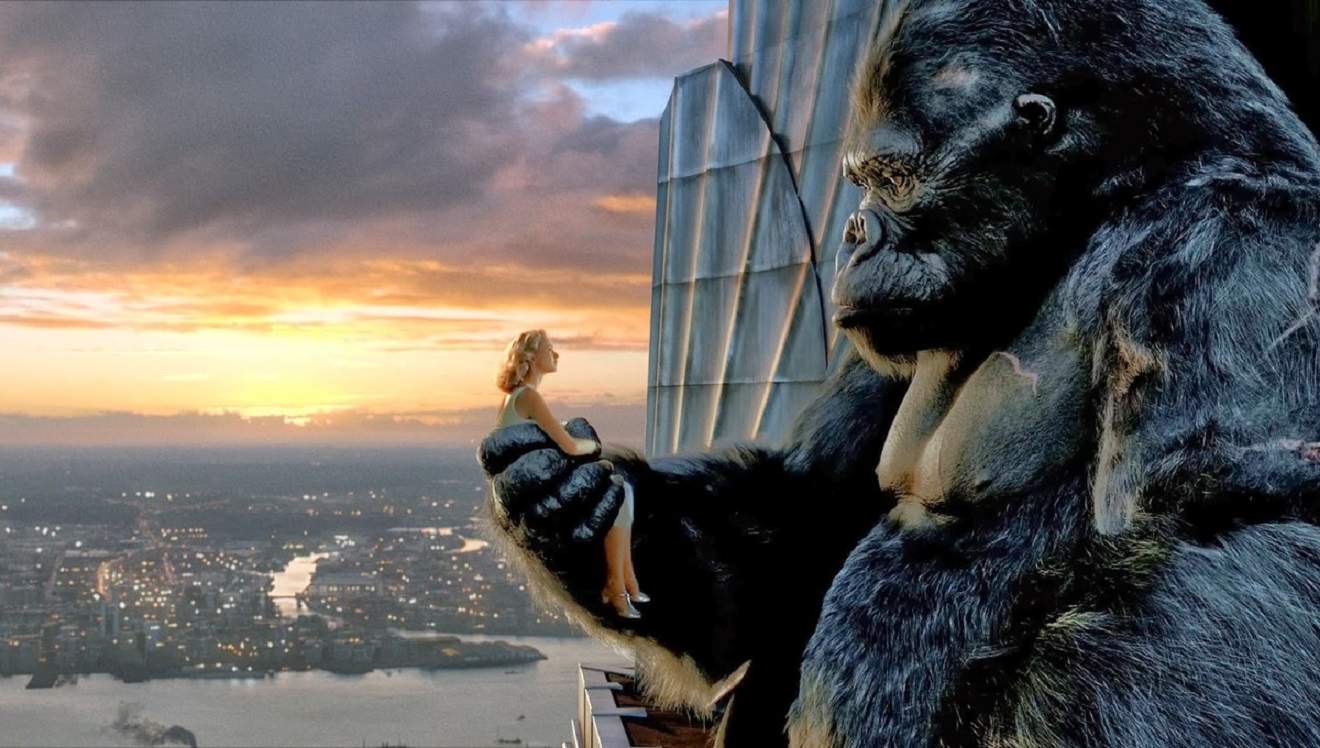
The casting of Adrien Brody as Jack Driscoll is a choice that has one scratching their head (especially considering that Brody was Peter Jackson’s only casting choice). Adrien Brody is not the most ready of actors that comes to mind when one thinks of romantic leading men and his Driscoll seems wimpy. The fact that Jackson and co rewrite Driscoll’s character over the original to now make him into a frustrated playwright forced to operate as Denham’s script boy kept reminding one of John Turturro as the longsuffering writer in the Coen Brothers’ Barton Fink (1991) and try as I might I could not get the image out of my head.
You also cannot help but think there something of an undeniable wish fulfilment upon Jackson’s part in his reinvention of the characters here – the heroes now consist of a misunderstood writer being told to write crap and a producer who only gains his stride when he takes a wild risk to create something daring. (It is not that hard to read Denham as being Peter Jackson the iconoclastic filmmaker who turned his back on Hollywood and ran with his own vision to the end of the world – or at least back to New Zealand). On the opposite side, the pompous figures of the film are all caricatures of negative Hollywood stereotypes – the vulgar and short-sighted financial backers and the vain, self-centred Hollywood leading man. Perhaps more than he realises, King Kong reflects as much of Peter Jackson’s dreams as it does his unconscious desires and frustrations.
Peter Jackson next went onto direct the heavily disappointing The Lovely Bones (2009) and returned to Middle-Earth with The Hobbit: An Unexpected Journey (2012), The Hobbit: The Desolation of Smaug (2013) and The Hobbit: The Battle of the Five Armies (2014). He has also produced District 9 (2009), The Adventures of Tintin (2011) and written/produced Mortal Engines (2018).
The other King Kong films are:
- The original King Kong (1933) starring Fay Wray, which produced a likeably silly sequel The Son of Kong (1933)
- In the 1960s, Japan’s Toho Studios revived Kong to take on their biggest star in King Kong Vs. Godzilla (1962) and then spun Kong off for a solo effort King Kong Escapes (1967) up against Mecha-Kong
- Producer Dino De Laurentiis made the infamous remake King Kong (1976) starring Jessica Lange, which is reviled by all fans of the original. De Laurentiis then later made an even worse sequel King Kong Lives (1986)
- Kong: Skull Island (2017) was a reboot introducing Kong into a shared universe with Godzilla and was followed by Godzilla vs. Kong (2021)
- There were two animated tv series with the Japanese The King Kong Show (1966-8) and then the US made Kong: The Animated Series (2000-1). The latter also had two films spinoffs with Kong, King of Atlantis (2005) and Kong: Return to the Jungle (2006)
- Kong also makes cameos in The Lego Batman Movie (2017), Ready Player One (2018) and Space Jam: A New Legacy (2021). There have been numerous spoofs most notedly Queen Kong (1976) and an adult version Kinky Kong (2006)
(Winner in this site’s Top 10 Films of 2005 list. Winner for Best Special Effects, Nominee for Best Director (Peter Jackson), Best Adapted Screenplay, Best Actor (Jack Black) and Best Actress (Naomi Watts) at this site’s Best of 2005 Awards).
Trailer here

